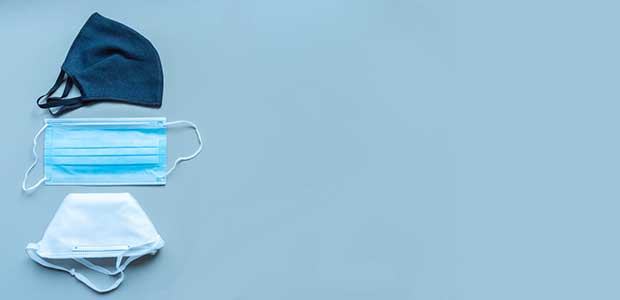
A Mask User Guide: Which Protects You Best?
Face coverings are recommended across the country and required in many places. But how do you know what type of mask, or fabric, is best? Here’s a user guide to understanding your options.
So you want to wear a mask? Great. But remember, not all masks are created equal.
A growing body of evidence supports the idea that wearing a mask in public significantly reduces the spread of a disease like COVID-19, even when you feel well. People can be asymptomatic or pre-symptomatic, so wearing a mask is less about protecting yourself and more about protecting others.
The CDC references a number of studies that suggests face coverings are crucial for slowing spread.
However, when wearing a face covering or mask—whether with a bandana, fabric mask, surgical mask or other—it is important to understand how effective each one is, and how you can make them safer.
Remember, no mask will offer full protection, and they should not be viewed as a replacement of social distancing or hand-washing hygiene tips. Keeping your distance from others and washing your hands are still very important.
But what kind of mask is best? One NPR piece addresses this question (as does the CDC’s website).
When choosing a mask, you should consider the fabric, fit and breathability. What a mask is made of is just as important as how well it fits your face.
Here’s a look a different face coverings and masks, and how each function.
Fabric Masks
Fabric first. “The tightness of the weave is really important. That’s the first thing I would ask people to look into,” says Supratik Guha, a professor of molecular engineering at the University of Chicago.
You can check the fabric if you hold it up to a light: if you can easily see the outline of the individual fibers, it will not make a good filter.
Researchers say a thick 100-percent cotton wave is a safe choice. Cotton tends to work better than synthetic materials, although synthetic materials is better than nothing at all.
Layers, layers, layers. Basically, the more layers of fabric you have between your mouth and others, the better. If you mask is made of multiple layers, the particles have more fabric to get through.
A good option: a mask made of two layers of a thick-weave fabric with a built-in pocket where you can place a filter, says May Chu, an epidemiologist at the Colorado School of Public Health who co-authored a paper published on June 2 in Nano Letters on the filtration efficiency of household mask materials.
If you don’t have access to this option, you take two sheets of facial tissue, old them over and put them inside your mask’s pocket so you have a four-layer filter.
If neither of those are options, a mask made of three or more layers of tightly woven cotton will also do a decent job, Chu says.
Shape up. Shape does matter, and a mask’s ability to filter out particles largely depends on how it shapes to your face. The tighter the seal of your mast to your face, the better (although be careful to not cut off circulation). If air leaks through the sides of the mask, this increases your risk.
Masks with exhalation valves. The article explains that masks with exhalation valves at the front should be avoided. “The valve makes it easier to breathe out, but it also releases unfiltered air, so it doesn't protect others if you're contagious. And protecting others is the primary reason to wear a mask.”
Keep it clean. Experts say cloth masks should be washed daily with soap or detergent and hot water. Make sure the mask is totally dry before you wear it again, as a damp mask can promote the growth of microorganisms.
Medical Masks
N95 respirators. N95 respirators are designed to create a tight seal around the nose and mouth. When worn correctly, they can block at least 95 percent of small airborne particles.
“N95s are made out of many layers of fine polypropylene fibers, which, as we’ve discussed, use the power of static electricity to trap incoming and outgoing particles and droplets.”
However, N95s are still in short supply, and experts implore citizens not to purchase them so that healthcare workers and first responders have enough.
The CDC has some tips on identifying a counterfeit respirator.
KN95 respirators. Like N95s, these respirators are supposed to filter 95 percent of small airborne particles. However, they are regulated by the Chinese government, and testing has shown that the actual performance of many KN95s for sale in the US is “all over the place,” and many are counterfeit.
Here’s a tip: If the packaging says it’s NIOSH approved, don’t trust it—an U.S. government agency like NIOSH (the National Institute for Occupational Safety and Health) would not approve a mask made to another country's standard.
Surgical masks: Surgical masks are disposable coverings worn loosely around the face. However, they are thinner and prove to be a little less consistently protective.
The article explains: “Research has found that surgical masks can block the vast majority of respiratory droplets emitted by an infected person. But how well a surgical mask protects you, the wearer, from smaller particles can vary widely when tested with the same methods used to test N95 respirators. For example, one surgical mask that Cui tested blocked around 30 percent of small particles, while others filtered out up to 80 percent.”
The US Surgeon General has a helpful video on how you can make your own face coverings at home:
At the end of the day, remember that masks are crucial to controlling the spread of COVID-19—in public, in the workplace and elsewhere. They are more about protecting others than they are about protecting yourself. But selecting a mask can be a difficult decision, so make sure you understand the pros and cons of your options.